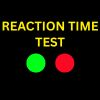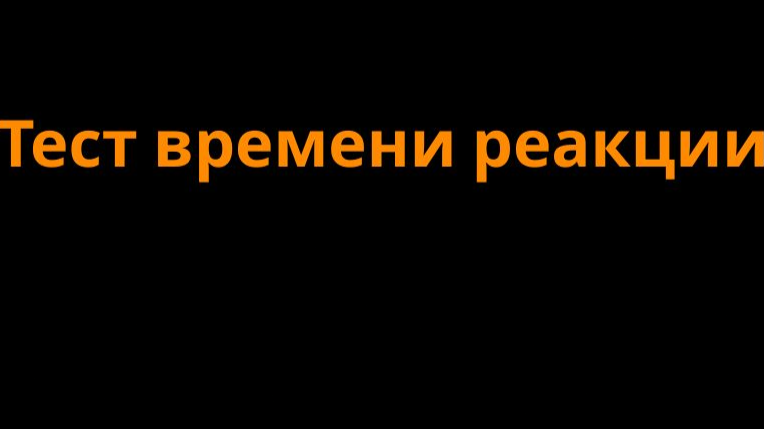

Reaction Time Test
Тест времени реакции предназначен для оценки скорости вашей реакции на изменение цвета.
В течение нескольких секунд вы будете видеть красный экран, и как только он станет зеленым, вам нужно будет щелкнуть мышью по экрану теста. Время отображения красного экрана меняется каждый раз, чтобы вы оставались внимательными и не могли рассчитывать, когда появится зеленый экран.
Тест состоит из 5 вопросов, что означает, что вы можете пройти его за 5 кликов.
На ваши результаты может повлиять задержка устройств и экрана/монитора, которые вы используете. По возможности, постарайтесь пройти тест на быстром компьютере и экране/мониторе с высокой частотой обновления.
Этот тест разработан как развлекательный и образовательный инструмент. Результаты не являются психологической или психиатрической оценкой и могут не давать точного представления о психическом здоровье участника теста. Мы не гарантируем точность результатов, и они не должны использоваться в качестве показателя способностей человека для конкретных целей.
Как улучшить время реакции
Практикуйтесь и повторяйте
Регулярные упражнения на время реакции — один из самых эффективных способов улучшить рефлексы и скорость мышления. При постоянной тренировке времени реакции мозг начинает более эффективно обрабатывать поступающие стимулы и быстрее отправлять сигналы мышцам.
Когнитивные упражнения, такие как визуальные или слуховые реактивные упражнения, игры на быстрое принятие решений и упражнения на координацию рук и глаз, помогают укрепить нейронные связи между мозгом и телом. Со временем такая повторяющаяся стимуляция сокращает задержку между восприятием и действием.
По сути, ваш мозг учится обходить ненужную умственную обработку и преобразует сознательные реакции в автоматические ответы. Регулярные тренировки позволяют научить тело реагировать почти инстинктивно, улучшая результаты в спорте, играх и повседневных задачах.
Делайте частые перерывы
Частые перерывы между упражнениями на реакцию необходимы для поддержания оптимальной концентрации и производительности. Когда вы даете нервной системе возможность перезагрузиться после каждого подхода, это помогает мозгу и телу восстановить силы после умственного переутомления, благодаря чему вы остаетесь бодрыми и внимательными к следующему раунду.
Со временем постоянные тренировки приводят к постепенному улучшению скорости реакции, даже если сначала прогресс кажется минимальным. Однако, если время реакции начинает замедляться, а не улучшаться, это может указывать на такие факторы, как усталость, разочарование или недостаток концентрации. Отдых помогает предотвратить переутомление и поддерживает эффективную работу нервной системы.
Короткие паузы, глубокое дыхание или легкая растяжка между упражнениями могут освежить ум, улучшая вашу способность быстро и точно реагировать.
Блокируйте любые отвлекающие факторы и сохраняйте спокойствие
Умение блокировать отвлекающие факторы имеет решающее значение для улучшения времени реакции и поддержания полной концентрации внимания. Когда ваш мозг свободен от ненужных раздражителей, он может посвятить всю свою вычислительную мощность решению поставленной задачи. Повышенная концентрация позволяет быстрее воспринимать изменения и более точно реагировать на них.
Достижение такого уровня сосредоточенности требует постоянной практики, поскольку мозг по своей природе остается внимательным к окружающей среде. Такие техники, как осознанность и медитация, могут помочь тренировать ваш ум, чтобы отфильтровывать нерелевантную информацию и сохранять спокойствие в стрессовых ситуациях.
Если отвлекающие факторы постоянно захватывают ваше внимание, ваш мозг в конечном итоге делит свои ресурсы между несколькими стимулами, замедляя вашу скорость реакции. Регулярные тренировки сосредоточенности позволяют укрепить умственную дисциплину и реагировать с большей точностью.
Разогрейте руки
Разогрев рук перед началом теста на время реакции — простой, но эффективный способ улучшить свои результаты. Легкие упражнения для рук и пальцев увеличивают кровоток, расслабляют мышцы и улучшают координацию, позволяя телу реагировать быстрее.
Когда мышцы расслаблены и гибки, они быстрее передают сигналы от мозга, что приводит к более быстрым и точным движениям. Однако важно не перенапрягать руки или тело, так как скованность может замедлить ваши реакции. Легкая растяжка, вращение запястий или сгибание пальцев могут подготовить ваши руки к быстрым действиям, не вызывая усталости.
Сохраняя руки теплыми и активными, вы обеспечиваете готовность мышц и нервной системы к оптимальной скорости и точности.
Наука, лежащая в основе времени реакции
Время реакции включает в себя сложные нейронные процессы. Когда появляется стимул:
1. Сенсорные рецепторы обнаруживают стимул.
2. Нейронные сигналы передаются в мозг.
3. Мозг обрабатывает информацию и принимает решение о реакции.
4. Моторные сигналы передаются в соответствующие мышцы.
5. Мышцы выполняют физическую реакцию.
Часто задаваемые вопросы
1. Что такое Тест времени реакции?
Тест времени реакции измеряет, насколько быстро вы реагируете на изменение цвета на экране, оценивая ваши рефлексы и координацию мозга и тела.
2. Сколько попыток предусмотрено в тесте?
Тест состоит из 5 раундов, и вам нужно нажать кнопку, как только экран станет зеленым, чтобы точно измерить время реакции.
3. Какие факторы влияют на результаты теста на время реакции?
Задержка устройства, частота обновления экрана, усталость и отвлекающие факторы могут повлиять на скорость вашей реакции и точность результатов теста.
4. Как я могу улучшить свое время реакции?
Регулярные тренировки, когнитивные упражнения, медитация и сохранение спокойствия, избегая отвлекающих факторов, могут помочь эффективно улучшить время реакции.
5. Является ли этот тест медицинской оценкой?
Нет, тест предназначен исключительно для образовательных и развлекательных целей и не должен использоваться для психологической или медицинской диагностики.
Заключение
Время реакции — это увлекательное отражение эффективности взаимодействия мозга и тела. Оно показывает, насколько быстро мы можем воспринимать, обрабатывать и реагировать на внешние стимулы — навыки, которые важны не только в спорте или играх, но и в повседневной жизни. Хотя на результаты могут влиять такие факторы, как задержка устройства или усталость, постоянная практика, концентрация и умственные тренировки могут привести к заметным улучшениям со временем.
Выполнение когнитивных упражнений, поддержание спокойной концентрации и поддержание тела в активном состоянии — все это способствует более быстрой и надежной реакции. Самое главное, помните, что этот тест предназначен для образовательных и развлекательных целей — он дает ценную информацию о вашей когнитивной скорости, но не должен рассматриваться как профессиональная оценка ваших умственных способностей.
С терпением и регулярными тренировками любой может улучшить свое время реакции и отточить координацию ума и тела для лучшей производительности в любой деятельности, требующей быстрых рефлексов.
